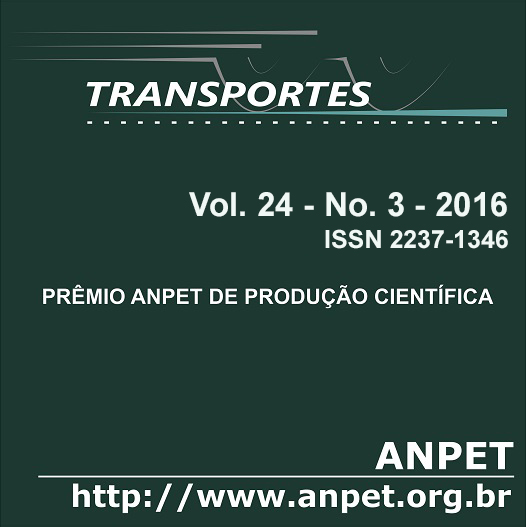Avaliação do resíduo de óleo vegetal como agente rejuvenescedor de ligantes a partir de análises reológicas e de morfologia de superfície
DOI:
https://doi.org/10.14295/transportes.v24i3.1147Keywords:
Asphalt Binders, Rejuvenation, Vegetable Oil, Rheology, Surface Morphology.Abstract
This study evaluates the use of a waste vegetable oil as a rejuvenator of asphalt binders. For that, characteristics of a binder in the stages unaged, aged, and rejuvenated are evaluated based on results of viscosity, dynamic shear modulus and phase angle. In addition, tests to characterize the surface morphology are conducted in an atomic force microscope to identify microscopic changes on the different components of the binder. A procedure to quantify these constituents is pre-sented and employed in the research work. It is expected that the results presented in this paper can promote sustainable engineering practices with the use of waste products that are able to rejuvenate aged asphalt binders, as well as stimulate the development of advanced techniques to characterize the material behavior in different scales and to identify links between them.Downloads
References
AASHTO (2012) R28 Standard Practice for Accelerated Aging of Asphalt Binder Using a Pressurized Aging Vessel (PAV). American Association of State Highway and Transportation Officials.
AASHTO (2009) T240 Standard Method of Test for Effect of Heat and Air on a Moving Film of Asphalt (Rolling Thin-Film Oven Test). American Association of State Highway and Transportation Officials.
Asli, H., Ahmadinia, E., Zargar, M., Karim, M. R. (2012) Investigation On Physical Properties of Waste Cooking Oil - Rejuvenated Bitumen Binder, Construction and Building Materials, v. 37, p. 398-405. DOI: 10.1016/j.conbuildmat.2012.07.042.
Dantas, L. N. (2015) Estudo do envelhecimento de ligantes asfálticos. Tese de Doutorado, COPPE, Universidade Federal do Rio de Janeiro, Rio de Janeiro, RJ, Brasil.
Dantas, L. N., Motta, L. M. G., Simão, R. A. (2014) O uso da microscopia de força atômica (AFM) na avaliação do envelhecimento de ligantes asfálticos, 21º Encontro de Asfalto, IBP, Rio de Janeiro, IBP335_14.
Davis, C., Castorena, C. (2015) Implications of physico–chemical interactions in asphalt mastics on asphalt microstructure, Construction and Building Materials, v.94, pp. 83-89. DOI: 10.1016/j.conbuildmat.2015.06.026.
Dedene, C. D. (2011) Investigation of using waste engine oil blended with reclaimed asphalt materials to improve pavement recyclability. Dissertação de mestrado, Michigan Technology University, Houghton, Michigan, USA.
Dedene, C. D., You, Z. (2014) The Performance of Aged Materials Rejuvenated with Waste Engine Oil, International Journal of Pavement Research & Technology, v. 7, n. 2, p.145-152.
Guern, M. L., Chailleux, E., Farcas, F., Dreessen, S., Mabille, I. (2010) Physico-Chemical Analysis of 5 Bitumens: Identification of Chemical Species and Molecular Organization Before After Aging, Fuel, v. 89, p. 3330-3339. DOI: 10.1016/j.fuel.2010.04.035.
Jäger, A., Lackner, R., Eisenmenger-Sittner, C., Blab, R. (2004) Identification of four material phases in bitumen by atomic force microscopy, Road Materials and Pavement Design, v. 5, pp. 9-24. DOI: 10.1080/14680629.2004.9689985.
Loeber, L., Muller, G., Morel, J., Sutton, O. (1998) Bitumen in colloid science: a chemical, structural and rheological approach, Fuel, v. 77, n. 13, pp. 1443-1450. DOI: 10.1016/S0016-2361(98)00054-4.
Lu, X., Isacsson, U. (2002) Effect of Ageing On Bitumen Chemistry and Rheology, Construction and Building Materials, v.16, p. 15-22. DOI: 10.1016/S0950-0618(01)00033-2.
Masson, J. F., V. Leblond, V., Margeson, J. (2006) Bitumen morphologies by phase-detection atomic force microscopy, Journal of Microscopy, v. 221, pp. 17-29. DOI: 10.1111/j.1365-2818.2006.01540.x.
Menapace, I., Masad, E., Bhasin, A., Little, D. (2015) Microstructural properties of warm mix asphalt before and after laboratory simulated long-term ageing, Road Materials and Pavement Design, v. 16, pp. 2-20. DOI: 10.1080/14680629.2015.1029692.
Nahar, S., Qiu, J., Schmets, A., Schlangen, E., Shirazi, M., Ven, M. V., Schitter, G., Scarpas, A. (2014) Turning Back Time: Rheological and Microstructural Assessment of Rejuvenated Bitumen, 93rd Annual Meeting of the Transportation of Research Board, TRB, Washington, D. C., USA.
Nazzal, M. D., Qtaish, L. A. (2013) The Use of Atomic Force Microscopy to Evaluate Warm Mix Asphalt. In: Report FHWA/OH-2012/19, Ohio University, Columbus, Ohio, USA.
Pauli, A. T., Grimes, R. W., Beemer, A. G., Turner, T. F., Branthaver, J. F. (2011) Morphology of asphalts, asphalt fractions and model wax-doped asphalts studied by atomic force microscopy, International Journal of Pavement Engineering, v. 12, pp. 291-309. DOI: 10.1080/10298436.2011.575942.
Rebelo, L. M., Sousa, J. S., Abreu, A. S., Baroni, M. P. M. A., Alencar, A. E. V., Soares, S. A., Mendes, J. F., Soares, J. B. (2014) Aging of Asphaltic Binders Investigated with Atomic Force Microscopy, Fuel, v. 117, p. 15-25. DOI: 10.1016/j.fuel.2013.09.018.
Silva, L. S. (2005) Contribuição ao estudo do envelhecimento de ligantes asfálticos. Influência da adição de polímeros e comportamento frente a radiação UV. Tese de doutorado, Universidade Federal do Rio Grande do Sul, Porto Alegre, RS, Brasil.
Veytskin, Y., Bobko, C., Castorena, C. (2015) Nanoindentation and Atomic Force Microscopy Investigations of Asphalt Binder and Mastic, Journal of Materials in Civil Engineering, v. 28, pp. 1-16. DOI: 10.1061/(ASCE)MT.1943-5533.0001532.
Yu, X., Zaumanis, M., Santos, S., Poulikakos, L. D. (2014) Rheological, Microscopic, And Chemical Characterization of the Rejuvenating Effect On Asphalt Binders, Fuel, v. 135, p. 162-171. DOI: 10.1016/j.fuel.2014.06.038.
Zhang, H. L., Yu, J. Y., Feng, Z. G., Xue, L. H, Wu, S. P. (2011) Effect of Aging On the Morphology of Bitumen by Atomic Force Microscopy, Journal of Microscopy, v. 246, p. 11-19. DOI: 10.1111/j.1365-2818.2011.03578.x.
Zargar, M., Ahmadinia, E., Asli, H., Karim, M. R. (2012) Investigation of The Possibility of Using Waste Cooking Oil as A Rejuvenating Agent for Aged Bitumen, Journal of Hazardous Materials, v.233-234, p. 254-258. DOI: 10.1016/j.jhazmat.2012.06.021.
Zaumanis M., Mallick R. B., Frank R. (2014) Determining Optimum Rejuvenator Dose for Asphalt Recycling Based On Superpave Performance Grade Specifications, Construction and Building Materials, v.69, p. 159-166. DOI: 10.1016/j.conbuildmat.2014.07.035
Downloads
Published
How to Cite
Issue
Section
License
Authors who submit papers for publication by TRANSPORTES agree to the following terms:
- The authors retain the copyright and grant Transportes the right of first publication of the manuscript, without any financial charge, and waive any other remuneration for its publication by ANPET.
- Upon publication by Transportes, the manuscript is automatically licensed under the Creative Commons License CC BY 4.0 license. This license permits the work to be shared with proper attribution to the authors and its original publication in this journal, and to be adapted for non-commercial purposes, provided appropriate credit is given and any derivative works are distributed under the same terms.
- Authors are authorized to enter into additional separate contracts for the non-exclusive distribution of the version of the manuscript published in this journal (e.g., publishing in an institutional repository or as a book chapter), with recognition of the initial publication in this journal, provided that such a contract does not imply an endorsement of the content of the manuscript or the new medium by ANPET.
- Authors are permitted and encouraged to publish and distribute their work online (e.g., in institutional repositories or on their personal websites) after the editorial process is complete. As Transportes provides open access to all published issues, authors are encouraged to use links to the DOI of their article in these cases.
- Authors guarantee that they have obtained the necessary authorization from their employers for the transfer of rights under this agreement, if these employers hold any copyright over the manuscript. Additionally, authors assume all responsibility for any copyright infringements by these employers, releasing ANPET and Transportes from any responsibility in this regard.
- Authors assume full responsibility for the content of the manuscript, including the necessary and appropriate authorizations for the disclosure of collected data and obtained results, releasing ANPET and Transportes from any responsibility in this regard.









